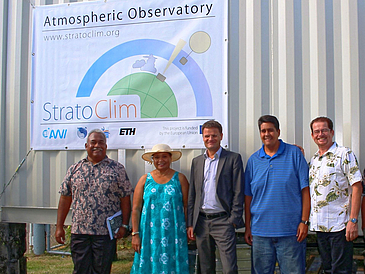The University of Bremen’s Institute for Environmental Physics and the Alfred Wegener Institute, Helmholtz Centre for Polar and Marine Research (AWI) have opened an atmosphere observatory on the campus of the Palau Community College (PCC). Palau is a small island state in the West Pacific with just 21,000 inhabitants.
The new observatory is part of the European climate research project StratoClim, a consortium of 28 European research organizations led by AWI, and is operated in close collaboration with the PCC.
Global significance for climate research
Recent atmospheric research has shown the particular importance of the upper troposphere and stratosphere (UTS) for the Earth’s climate. The UTS is located at altitudes above about 16 kilometers. Scientists have found out that the main transport of air into the stratosphere occurs above the tropical West Pacific warm pool. But this area constitutes a gap in existing observational networks, and information on atmospheric composition from this region is very limited. Complicated interactions between chemical processes, aerosol and cloud formation in the region substantially change the composition of the air during its rise. Once they have arrived in the UTS, the air masses spread out from the ascent area to all over the globe. Therefore they also determine the atmospheric composition in Europe and the Arctic.
Examining the chemical properties of air
Palau is located in the center of the restricted ascent area. Samoa is another measuring station located on the Pacific rim. According to StratoClim leader Dr. Markus Rex from the Alfred Wegener Institute, the location was chosen because “The new observatory allows us to study on-site the processes which determine the UTS’s composition on a global scale. He goes on to explain: “Measurements conducted at the new Atmospheric Observatory are of highest relevance for better understanding the climate of our planet and fill a key gap in the existing observational network”.
Stations in Bremen, Spitzbergen, and the West Pacific
An environmental physicist from the University of Bremen, Professor Justus Notholt, is responsible for taking the measurements of trace gases at the observatory in Palau. To do this he uses a Fourier Transform Infrared Spectrometer. A similar measuring station is located on the roof of Building NW1 on the campus of the University of Bremen. “We are very happy that besides Spitzbergen and other locations we can now use the station in the West Pacific to complement our own measurements”, says Professor Notholt. Winfried Markert, a PhD student at the University of Bremen’s Institute for Environmental Physics, is visiting Palau from December to February to work on his doctoral thesis. During his research stay he helped install the container and he is now carrying out the first measurements.
Promoting exchange on-site
The measurements will be complemented by an educational program at PCC consisting of a series of lectures on climate issues delivered by internationally renowned climate scientists from the StratoClim consortium.

